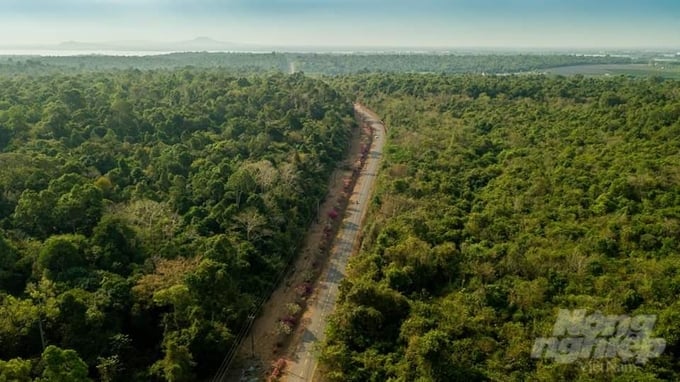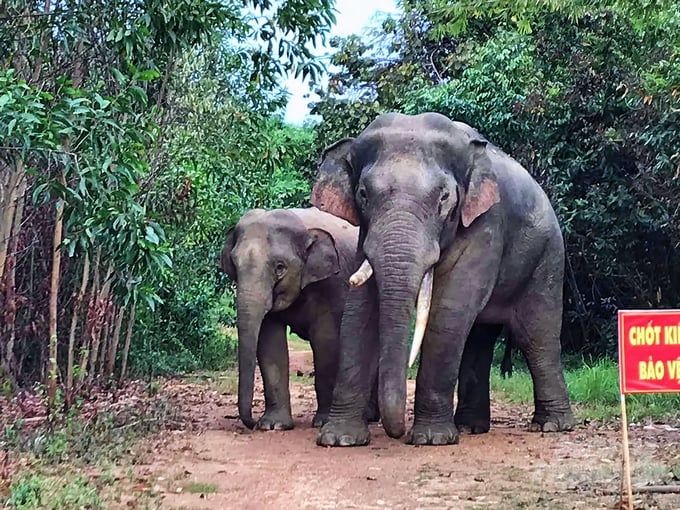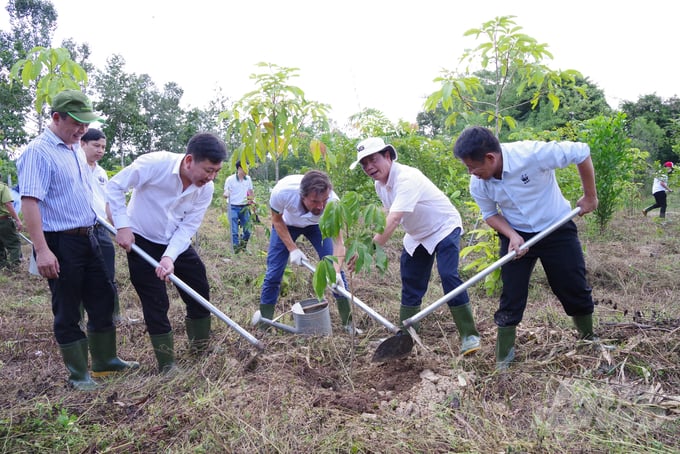May 22, 2025 | 09:44 GMT +7
May 22, 2025 | 09:44 GMT +7
Hotline: 0913.378.918
May 22, 2025 | 09:44 GMT +7
Hotline: 0913.378.918

Dong Nai Nature - Culture Reserve seen from above.
Dong Nai closed the forest in 1997 and established the Dong Nai Culture and Nature Reserve in 2004, managing a total natural area of over 100,000 ha. In which, more than 68,000 ha of forestry land and more than 32,000 ha of water surface of Tri An Lake.
Since then, many endemic and rare animal and plant species here have been restored. This place has diverse and rich biological resources, with more than 1,400 species of plants; diverse forest vegetation. In addition, the reserve has 1,700 species of wild animals and insects, of which many species belong to the endangered, precious, rare, and endemic groups, such as Asian elephants, gaurs, etc.
This place is one of 200 critical ecological zones in the world and one of the 13 priority zones of Southeast Asia. Not only that, the reserve is also part of an urgent ecological conservation sub-region within the Truong Son ecosystem. It is a priority habitat identified by the Vietnam Conservation Fund. The reserve is also located in the endemic bird area of Southern Vietnam.

Dong Nai province currently has about 20 Asian elephants. They often feed in Cat Tien National Park, Dong Nai Nature and Culture Reserve.
Currently, the reserve is managing and protecting the wetlands of Tri An Lake (over 32,000 ha), Ba Hao Lake (400 ha), and many small wetland habitats interspersed glades in natural forests and systems of small rivers and streams with seasonal water.
Nguyen Hoang Hao, Director of Dong Nai Nature and Culture Reserve Area, said that in addition to the values of biodiversity, the reserve also has a geographical location near urban centers and industrial development of big business centers. Therefore, the forest ecosystem of the reserve is more valuable and plays an essential role in air conditioning, minimizing impacts from industrial emissions, urban emissions, and improving people's living environment.

In addition to the resources typical for the Southeast forest type and the protection values of the ecosystem, the reserve also has cultural-historical values, prominently the revolutionary bases. Here, there are many historical sites during the resistance wars, with the famous site being War Zone D. Currently, the reserve is assigned to manage three national historical and cultural relics: the relic of the Central Base of the Southern Department, The base of the Party Committee of the Southeast region and the Suoi Linh Tunnels Area.
With outstanding values of natural and cultural resources, in 2011, the reserve was recognized by UNESCO as the "Dong Nai World Biosphere Reserve". Together with Cat Tien National Park, Dong Nai Nature and Culture Reserve plays the role of the core area of the Biosphere Reserve.
To effectively protect the forests and wetlands of Tri An Lake, Director Hao said that the reserve had established 18 ranger stations, which are evenly distributed over the entire area managed by the unit.

The reserve has developed a nomination file for the Inland Wetland of Tri An Lake to become Vietnam's new Ramsar Site and a nomination for the title of ASEAN Heritage Park. This is a good sign that the organization of management, conservation, and restoration of the natural ecosystems of the reserve has a positive effect.
In addition to conservation, the reserve has planted and restored over 1,800 ha of native large timber forests and zoned, nurtured, and restored nearly 2,980 ha of natural forests. Mixed planting forests of native and rare species of woody plants, such as stars, red oak, etc., are planted to conserve rare genetic resources.
"In recent years, we have cooperated with companies, businesses, and units to carry out socializing afforestation with an area of over 40 ha," Hao informed.

Create conditions for people to care for and protect forests... to increase income. Photo: Nguyen Thuy.
To restore and develop aquatic resources, improve living standards, and create livelihoods for people living by fishing on Tri An Lake, the reserve annually re-releases about 2 million fingerlings of all kinds into Tri An Lake.
According to Hao, in the core area of the nature reserve, there are still six residential clusters living in Hamlets 2, 3, 4, 5, 6 (Ma Da commune) and Hamlet 3 (Hieu Liem commune), with nearly 2,000 households using of land managed by the reserve.
Take advantage of and bring into play the advantages of landscape resources of the buffer zone to develop livelihoods and improve productivity, quality, and production efficiency for people, especially households in remote and isolated areas, ethnic minorities in the buffer zone associated with forest protection and development, the conservation area has built an investment project in the buffer zone, approved by the People's Committee of Dong Nai province, implementation period from 2022 - 2026 and the conservation area is currently underway.

Leaders of the Ministry of Agriculture and Rural Development, WWF-Vietnam, and Heineken Vietnam participated in planting trees in the reserve. Photo: Nguyen Thuy.
In addition, the reserve has obtained funding from foreign organizations such as UNDP and WWF to improve local communities' living standards. In particular, to create jobs with stable and long-term income, the reserve has recruited children of ethnic minorities with appropriate qualifications to work at the unit.
In addition, the reserve cooperates with local authorities to preserve and promote the cultural values of ethnic minority communities, such as building and restoring the Dai house of the Cho Ro ethnic people, the organize festivals to worship rice gods and forest gods.
Director of Dong Nai Nature and Culture Reserve Area Nguyen Hoang Hao said that he hopes to have soon specific regulations on selling carbon credits so that forest owners can sell carbon credits, increase income for forest protection forces, and invest in better forest management, protection, and development.
Translated by Ha Phuc
![Reducing emissions from rice fields: [2] Farmers’ commitment to the soil](https://t.ex-cdn.com/nongnghiepmoitruong.vn/608w/files/news/2025/05/05/dsc08881jpg-nongnghiep-140632.jpg)
(VAN) Clean rice cultivation model in Thuong Tan commune, Bac Tan Uyen district, is assisting local residents in achieving sustainable agriculture by substantially reducing costs, increasing productivity, and protecting the environment.

(VAN) At the conference to disseminate Resolution No. 68, AgriS introduced its digital agricultural ecosystem and reaffirmed its commitment to accompanying the Government in promoting private sector development and sustainable agriculture.

(VAN) 'Blue Ocean - Blue Foods' initiative is designed to restore marine ecosystems and establish sustainable livelihoods for local communities by cultivating a minimum of 1,000 hectares of cottonii seaweed in the first three years.
/2025/05/21/4642-3-112707_603.jpg)
(VAN) The V-SCOPE project has made direct contributions to three out of six pillars of the Comprehensive Strategic Partnership between Vietnam and Australia.

(VAN) Facing the threat of rabies spreading to the community, Gia Lai province urgently carries out measures to vaccinate dogs and cats on a large scale.

(VAN) Disease-free livestock farming not only protects livestock herds but also stabilizes production and livelihoods for many farmers in Tuyen Quang.

(VAN) Japan's grant aid project contributes to capacity building, promoting organic agricultural production, and fostering sustainable community development in Dong Thap province.